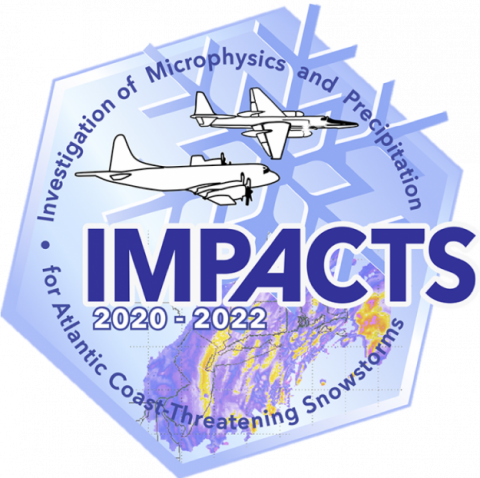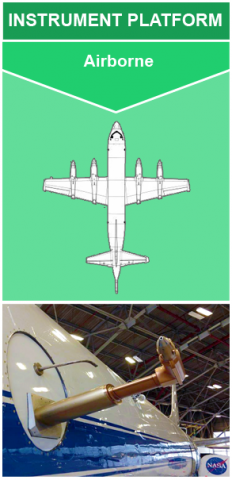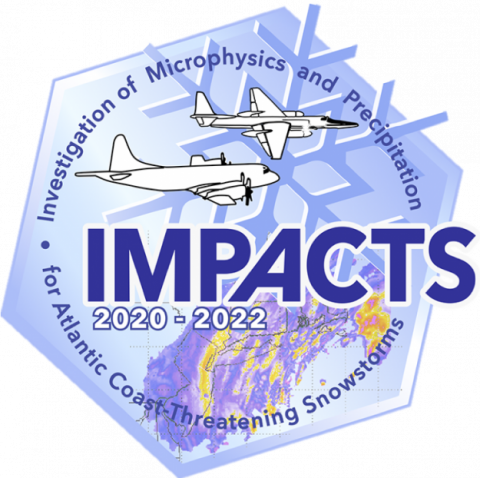 The NASA Global Hydrology Resource Center (GHRC) DAAC published the NASA S-Band Dual Polarimetric (NPOL) Doppler Radar IMPACTS dataset. This dataset consists of rain rate, reflectivity, Doppler velocity, and other radar measurements obtained from the NPOL radar during the Investigation of Microphysics and Precipitation for Atlantic Coast-Threatening Snowstorms (IMPACTS) field campaign. The goal of IMPACTS was to provide observations critical to understanding the mechanisms of snowband formation, organization, and evolution, examine how the microphysical characteristics and likely growth mechanisms of snow particles vary across snowbands, and improve snowfall remote sensing interpretation and modeling to significantly advance prediction capabilities. The IMPACTS NPOL data are available from January 10, 2020 thru February 25, 2020. Zipped data files are in netCDF-3/CF format and contain corrected radar reflectivity, differential reflectivity, specific differential phase, differential phase, co-polar correlation, and Doppler velocity images.
The NASA Global Hydrology Resource Center (GHRC) DAAC published the NASA S-Band Dual Polarimetric (NPOL) Doppler Radar IMPACTS dataset. This dataset consists of rain rate, reflectivity, Doppler velocity, and other radar measurements obtained from the NPOL radar during the Investigation of Microphysics and Precipitation for Atlantic Coast-Threatening Snowstorms (IMPACTS) field campaign. The goal of IMPACTS was to provide observations critical to understanding the mechanisms of snowband formation, organization, and evolution, examine how the microphysical characteristics and likely growth mechanisms of snow particles vary across snowbands, and improve snowfall remote sensing interpretation and modeling to significantly advance prediction capabilities. The IMPACTS NPOL data are available from January 10, 2020 thru February 25, 2020. Zipped data files are in netCDF-3/CF format and contain corrected radar reflectivity, differential reflectivity, specific differential phase, differential phase, co-polar correlation, and Doppler velocity images.GHRC News
 The NASA Global Hydrology Resource Center (GHRC) DAAC published the NASA S-Band Dual Polarimetric (NPOL) Doppler Radar IMPACTS dataset. This dataset consists of rain rate, reflectivity, Doppler velocity, and other radar measurements obtained from the NPOL radar during the Investigation of Microphysics and Precipitation for Atlantic Coast-Threatening Snowstorms (IMPACTS) field campaign. The goal of IMPACTS was to provide observations critical to understanding the mechanisms of snowband formation, organization, and evolution, examine how the microphysical characteristics and likely growth mechanisms of snow particles vary across snowbands, and improve snowfall remote sensing interpretation and modeling to significantly advance prediction capabilities. The IMPACTS NPOL data are available from January 10, 2020 thru February 25, 2020. Zipped data files are in netCDF-3/CF format and contain corrected radar reflectivity, differential reflectivity, specific differential phase, differential phase, co-polar correlation, and Doppler velocity images.
The NASA Global Hydrology Resource Center (GHRC) DAAC published the NASA S-Band Dual Polarimetric (NPOL) Doppler Radar IMPACTS dataset. This dataset consists of rain rate, reflectivity, Doppler velocity, and other radar measurements obtained from the NPOL radar during the Investigation of Microphysics and Precipitation for Atlantic Coast-Threatening Snowstorms (IMPACTS) field campaign. The goal of IMPACTS was to provide observations critical to understanding the mechanisms of snowband formation, organization, and evolution, examine how the microphysical characteristics and likely growth mechanisms of snow particles vary across snowbands, and improve snowfall remote sensing interpretation and modeling to significantly advance prediction capabilities. The IMPACTS NPOL data are available from January 10, 2020 thru February 25, 2020. Zipped data files are in netCDF-3/CF format and contain corrected radar reflectivity, differential reflectivity, specific differential phase, differential phase, co-polar correlation, and Doppler velocity images. The NASA Global Hydrology Resource Center (GHRC) DAAC published the Water Isotope System for Precipitation and Entrainment Research (WISPER) instrument micro article. WISPER measures condensed water contents and water vapor in clouds, along with water vapor isotopic abundances. This provides important information about the origin of air masses and possibly, microphysical processes. This micro article provides an overview of WISPER and its applications to support current and future dataset publications. The micro article is available at: https://ghrc.nsstc.nasa.gov/home/micro-articles/instrument-water-isotope-system-precipitation-and-entrainment-research-wisper
The NASA Global Hydrology Resource Center (GHRC) DAAC published the Water Isotope System for Precipitation and Entrainment Research (WISPER) instrument micro article. WISPER measures condensed water contents and water vapor in clouds, along with water vapor isotopic abundances. This provides important information about the origin of air masses and possibly, microphysical processes. This micro article provides an overview of WISPER and its applications to support current and future dataset publications. The micro article is available at: https://ghrc.nsstc.nasa.gov/home/micro-articles/instrument-water-isotope-system-precipitation-and-entrainment-research-wisper
 The NASA Global Hydrology Resource Center (GHRC) DAAC published the GOES IMPACTS dataset. This dataset consists of single reflective band radiance products from the Advanced Baseline Imager (ABI) onboard the GOES-16 geostationary satellite. These data were collected in support of the Investigation of Microphysics and Precipitation for Atlantic Coast-Threatening Snowstorms (IMPACTS) field campaign. IMPACTS was a three-year sequence of winter season deployments conducted to study snowstorms over the U.S Atlantic Coast (2020-2022). The campaign aimed to (1) Provide observations critical to understanding the mechanisms of snowband formation, organization, and evolution; (2) Examine how the microphysical characteristics and likely growth mechanisms of snow particles vary across snowbands; and (3) Improve snowfall remote sensing interpretation and modeling to significantly advance prediction capabilities. The GOES IMPACTS dataset files are available in netCDF-4 format from January 1 through February 29, 2020. This dataset contains data from the GOES-16 CONUS and Mesoscale sectors, although IMPACTS uses a subset of the GOES-16 CONUS domain. The complete collection of GOES data is available from the NOAA Comprehensive Large Array-Data Stewardship System (CLASS). It should be noted that this dataset will be updated in subsequent years of the IMPACTS campaign.
The NASA Global Hydrology Resource Center (GHRC) DAAC published the GOES IMPACTS dataset. This dataset consists of single reflective band radiance products from the Advanced Baseline Imager (ABI) onboard the GOES-16 geostationary satellite. These data were collected in support of the Investigation of Microphysics and Precipitation for Atlantic Coast-Threatening Snowstorms (IMPACTS) field campaign. IMPACTS was a three-year sequence of winter season deployments conducted to study snowstorms over the U.S Atlantic Coast (2020-2022). The campaign aimed to (1) Provide observations critical to understanding the mechanisms of snowband formation, organization, and evolution; (2) Examine how the microphysical characteristics and likely growth mechanisms of snow particles vary across snowbands; and (3) Improve snowfall remote sensing interpretation and modeling to significantly advance prediction capabilities. The GOES IMPACTS dataset files are available in netCDF-4 format from January 1 through February 29, 2020. This dataset contains data from the GOES-16 CONUS and Mesoscale sectors, although IMPACTS uses a subset of the GOES-16 CONUS domain. The complete collection of GOES data is available from the NOAA Comprehensive Large Array-Data Stewardship System (CLASS). It should be noted that this dataset will be updated in subsequent years of the IMPACTS campaign. The NASA Global Hydrology Resource Center (GHRC) DAAC published the NCSU Soundings IMPACTS dataset. This dataset consists of atmospheric sounding data collected by the North Carolina State University student sounding club. These data include vertical profiles of atmospheric temperature, relative humidity, pressure, wind speed, and wind direction. These rawinsondes were launched from Raleigh, NC in support of the Investigation of Microphysics and Precipitation for Atlantic Coast-Threatening Snowstorms (IMPACTS) field campaign. IMPACTS was a three-year sequence of winter season deployments conducted to study snowstorms over the U.S Atlantic Coast (2020-2022). The campaign aimed to (1) Provide observations critical to understanding the mechanisms of snowband formation, organization, and evolution; (2) Examine how the microphysical characteristics and likely growth mechanisms of snow particles vary across snowbands; and (3) Improve snowfall remote sensing interpretation and modeling to significantly advance prediction capabilities. The sounding data files are available in netCDF-4 format for February 20, 2020.
The NASA Global Hydrology Resource Center (GHRC) DAAC published the NCSU Soundings IMPACTS dataset. This dataset consists of atmospheric sounding data collected by the North Carolina State University student sounding club. These data include vertical profiles of atmospheric temperature, relative humidity, pressure, wind speed, and wind direction. These rawinsondes were launched from Raleigh, NC in support of the Investigation of Microphysics and Precipitation for Atlantic Coast-Threatening Snowstorms (IMPACTS) field campaign. IMPACTS was a three-year sequence of winter season deployments conducted to study snowstorms over the U.S Atlantic Coast (2020-2022). The campaign aimed to (1) Provide observations critical to understanding the mechanisms of snowband formation, organization, and evolution; (2) Examine how the microphysical characteristics and likely growth mechanisms of snow particles vary across snowbands; and (3) Improve snowfall remote sensing interpretation and modeling to significantly advance prediction capabilities. The sounding data files are available in netCDF-4 format for February 20, 2020. The NASA Global Hydrology Resource Center (GHRC) DAAC published the Two-Dimensional Video Disdrometer (2DVD) IMPACTS dataset. These data were collected in support of the Investigation of Microphysics and Precipitation for Atlantic Coast-Threatening Snowstorms (IMPACTS) campaign. The IMPACTS field campaign addressed providing observations critical to understanding the mechanisms of snowband formation, organization, and evolution, examining how the microphysical characteristics and likely growth mechanisms of snow particles vary across snowbands, and improving snowfall remote sensing interpretation and modeling to significantly advance prediction capabilities. These data consist of the size, equivalent diameter, fall speed, oblateness, cross-sectional area of raindrops, particle concentration, total number of drops, total drop concentration, liquid water content, rain rate, reflectivity, and rain event characteristics. Data files are available from January 15, 2020 through February 28, 2020 in ASCII format.
The NASA Global Hydrology Resource Center (GHRC) DAAC published the Two-Dimensional Video Disdrometer (2DVD) IMPACTS dataset. These data were collected in support of the Investigation of Microphysics and Precipitation for Atlantic Coast-Threatening Snowstorms (IMPACTS) campaign. The IMPACTS field campaign addressed providing observations critical to understanding the mechanisms of snowband formation, organization, and evolution, examining how the microphysical characteristics and likely growth mechanisms of snow particles vary across snowbands, and improving snowfall remote sensing interpretation and modeling to significantly advance prediction capabilities. These data consist of the size, equivalent diameter, fall speed, oblateness, cross-sectional area of raindrops, particle concentration, total number of drops, total drop concentration, liquid water content, rain rate, reflectivity, and rain event characteristics. Data files are available from January 15, 2020 through February 28, 2020 in ASCII format.





